Career Fire Fighter Drowns During Final Dive of Training Course - Indiana
 Death in the Line of Duty…A summary of a NIOSH fire fighter fatality investigation
Death in the Line of Duty…A summary of a NIOSH fire fighter fatality investigation
F2002-15 Date Released: July 21, 2003
SUMMARY
On June 14, 2002, at approximately 1243 hours, a 37-year-old male career fire fighter (the victim) drowned during the final dive of a diver training course. The victim and his partner were attempting to locate and bring an object to the surface. They were using a lifting device in zero visibility at a depth of approximately 50 feet. The victim’s partner was in a kneeling position on the bottom of the lake attaching his line to the object when the victim knocked him over on his side and attempted to remove his mask. The victim’s weight belt landed on top of his partner. The partner surfaced and informed the personnel in the safety boat that the victim was in trouble. The safety diver immediately entered the water and began searching for the victim. Additional divers were shuttled to the site by the safety boat to continue searching for the victim. The victim was recovered over 2 hours later using a sonar device. Advanced life support was initiated en route to a local hospital where he was pronounced dead. NIOSH investigators concluded that, to minimize the risk of similar occurrences, fire departments should
- ensure that equipment checks are performed before each dive and any defective equipment is repaired or replaced before the dive takes place
- ensure that all participants in diver training have practiced the specific evolution in a controlled environment such as a swimming pool before attempting the evolution in open water
- ensure that search-and-rescue operations establish and use reference points to conduct searches
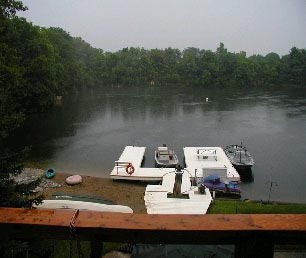
Dive class staging area
INTRODUCTION
On June 14, 2002, at approximately 1243 hours, a 37-year-old male career fire fighter (the victim) drowned during the final dive of a 21-day Open Water Self-Contained Underwater Breathing Apparatus (SCUBA) Diver training course.
On June 17, 2002, the U.S. Fire Administration and the International Association of Fire Fighters (IAFF) notified the National Institute for Occupational Safety and Health (NIOSH) of this incident. On July 8, 2002, two Safety and Occupational Health Specialists from the NIOSH Fire Fighter Fatality Investigation and Prevention Program investigated this incident. Meetings and interviews were conducted with the Chief, Senior Deputy Chief, District Chiefs, the Director of Special Operations and Training, fire fighters and divers who were on the scene, the dive instructor, and representatives from the IAFF. NIOSH reviewed copies of the fire department’s Standard Operating Procedures (SOPs), the dive training manual, the victim’s training records, the victim’s autopsy report, and drawings of the incident site. Investigators examined equipment that was the same model as what the victim was wearing. The incident site was visited and photographed.
At the request of the County Coroner’s Office, an evaluation of the victim’s dive equipment was conducted by the U.S. Department of the Navy Experimental Diving Unit (NEDU)1. The air tank was empty when it was delivered to NEDU; therefore, its contents could not be analyzed. The buoyancy compensator (BC) and first stage regulator were tested and found to work as designed. The second-stage regulator failed an exhaust flow test due to the exhaust diaphragm sticking shut. A protective shield ring on the mask, which was designed to keep debris out of the second-stage area, was missing. Sand was found inside the diaphragm area. The exhaust valve was disassembled and cleaned for testing; it worked as designed. It is not known if the protective shield ring was in place during the dive, or if the problems with the diaphragm existed during the dive or resulted from losing the protective ring during recovery efforts allowing sand to enter the device.
The career fire department involved in this incident consists of 747 uniformed fire fighters. The department serves a population of approximately 400,000 in a geographical area of about 93 square miles.
Training
The department requires all new fire fighters to complete NFPA Fire Fighter Level I and Level II certification. Upon entering the department, and annually thereafter, all fire fighters must pass a physical examination which consists of medical screening, psychological evaluation, personal fitness evaluation, blood work, physiologic evaluations, random drug testing, and a flexibility test. The victim was taking this diver certification course to become a member of the Dive and Rescue team. He had no other diving experience. Fire fighters on the Dive and Rescue team must pass the above tests in addition to evaluations which include endurance tests, body fat analysis, ear checks, and a blood pressure check. The victim had over 7 years of experience and had completed an extensive list of training courses which included Emergency Medical Technician, Hazardous Material Operations, Building Construction, Ladder Company Operations, and Driver Operator.
Diver Training
The Advanced Open Water SCUBA Diver course was a multi-agency certification course. The course was taught by an instructor who had been on contract since 1985 with several of the participating departments to provide diver training. The exercise the students were to carry out on their last day of instruction was to descend the buoy line that was anchored with a small weight to the bottom of the lake. They would then conduct a circular search pattern to locate a cinder block. The block had two milk jugs tethered to it that were to be cut and released to float to the surface (Diagram 1). This would indicate that the teams had found their object and were working on the lift. They would then each attach a 5-foot lanyard that had loops in either end to the cinder block using a metal shackle with a screw pin. The divers would then attach the other end of the lanyard to a 5-gallon bucket. The bucket would then be turned upside down so that the divers could expel air into it and lift the cinder block with both lines (Diagram 1).
Weather and Water Conditions
The weather on the day of the incident was reported to be sunny with temperatures in the mid-80s and calm winds.
The body of water in which the incident took place was a private lake with maximum depths near 70 feet. The dive operation was taking place at a depth of 50 feet where visibility was reported to be zero. The water temperature was reported to be approximately 40 degrees Fahrenheit.
INVESTIGATION
On June 14 2002, an Advanced Open Water SCUBA Diver course was being completed which consisted of conducting a final dive at a privately owned lake. The dive class included two certified National Association of Underwater Instructors (NAUI), six dive masters, and a total of 22 students. An instructor briefed the students on the scenario which would test their skills in manipulating equipment to lift an object from the bottom of the lake in zero visibility and cold water.
The staging area where the class was operating from included the dock, a beach, and a loading ramp where individuals were waiting to participate in the class (Photo 1). One instructor and a dive master in the safety boat placed buoy markers 30 to 40 feet apart in a straight line using the safety boat. The lines for the marker buoys were 50 feet long and were counter weighted so that the depth could be adjusted. The marker buoys were placed at a depth of approximately 50 feet (Photo 1 and Diagram 2). The crew then sank each block assembly within 5 to 10 feet of the marker buoys and returned to shore.
The dive teams checked in with the beach master and reported their air readings to ensure full tanks were being used before boarding the safety boat. The safety boat dropped each team at their respective buoys with the instruction to wait before beginning their final exercise. After all of the teams were in place at the surface near their buoy, the dive master in the safety boat gave them the signal to begin their dive.
The victim and his partner (Diver #1) were one of six two-person teams to attempt the last dive scenario. Upon receiving the command to begin, they descended the buoy line to a depth of approximately 50 feet to start their search pattern. The search pattern consisted of Diver #1 stationed at the anchor base, while the victim completed a circular search using a pivot line. Diver #1 would anchor a pivot line that the victim would use to conduct the circular search patterns around the buoy line. After each circle pattern, Diver #1 would give two tugs on the line to let the victim know that the pattern had been completed and that additional rope was being released.
The victim made two circles and gave two tugs on the line to indicate to Diver #1 that he had found the buoys attached to the cinder block. Diver #1 followed the pivot line to the victim and was talking to the victim as he swam toward his location. Note: The victim’s underwater communication system was not working properly at the time of the incident. He could hear but could not send transmissions (Photo 2 & Photo 3). Diver #1 gave the victim two squeezes on his arm, and the victim returned the two squeezes, which indicated that everything was alright.
The team then began to work on their scenario. Diver #1 started by cutting the milk jugs to release them to the surface. This would indicate to the surface personnel that they had found the block and had begun working on their objective. Diver #1 was in a kneeling position on the bottom and began to attach his 5-foot nylon line to the cinder block using a shackle. As Diver #1 was screwing the pin back into the shackle, the victim attempted to remove Diver #1’s facepiece. The force from the victim pushed Diver #1 over on his side, and the victim’s weight belt landed on the arm of Diver #1. The victim may have released his weight belt in an attempt to reach the surface.
Diver #1 inflated his buoyancy control device and immediately surfaced and reported to the safety boat that his partner was in trouble. The safety diver immediately entered the water, descended the buoy line, and attached his search line to the buoy line to conduct circular search patterns for the victim. During the safety diver’s fourth pattern, the crew on the safety boat raised the buoy line in an attempt to see if the victim might still be attached to the line. This brought up the safety diver, prematurely ending his search. The buoy line was dropped back down away from its initial location. Search patterns were continued off its new location. Additional divers were shuttled to the site by the safety boat to continue searching for the victim. The victim was recovered more than 2 hours later using a sonar device on a boat that was also on location. Advanced life support was initiated en route to a local hospital where he was pronounced dead.
CAUSE OF DEATH
The death certificate listed the cause of death as drowning.
RECOMMENDATIONS/DISCUSSIONS
Recommendation #1: Fire departments should ensure that equipment checks are performed before each dive and defective equipment is repaired or replaced before the dive takes place. 2
Discussion: Using the buddy system, divers should develop the habit of inspecting each others equipment for correct positioning, adjustment, air pressures, and function before entering the water. Whenever divers are using underwater electronic communication devices, all divers should ensure that the devices are working properly and have fully charged batteries. Divers should test communication equipment on the shore before diving and remain in contact with one another throughout the dive. In addition, personnel on the shore should be able to monitor communication among divers both above and below water through an electronic surface monitor. Any problems (e.g., low air, broken weight belt, malfunctioning communication equipment, etc.) should be reported to the dive instructor, logged, and repaired or replaced before the dive takes place.
Recommendation #2: Fire Departments should ensure that all participants in diver training have practiced the specific evolution in a controlled environment such as a swimming pool before attempting the evolution in open water. 3
Discussion: The complexity of public safety diving cannot be understated. Whenever new skills and/or equipment are introduced, it is important to gradually increase the level of complexity the diver is expected to master. Pool sessions that gradually increase the level of complexity would allow the diver to master the tasks and skills expected in a controlled situation, thus improving the chance of a positive outcome when the evolution is replicated in an open-water environment. A diver’s skills should be evaluated with the diver wearing the full complement of equipment that would be worn while performing in actual rescue situations. This skill evaluation should include underwater emergency procedures as well as the other skills needed to deliver public safety diving services.
In this incident the victim transported his 5-foot lanyard by attaching it to his vest with a D-ring. He attached one end of the lanyard to the cinder block, while the other end was still attached to his D-ring on his vest. For an unknown reason, the victim attempted to contact his partner. The victim removed his weight belt signifying distress in an attempt to reach the surface. When the victim was recovered, he was found attached to the cinder block by his lanyard. Practicing the specific steps that will be used in open water training dives in a controlled environment (e.g. swimming pool) under close supervision could assist in dealing with factors in a real environment.
Recommendation #3: Fire departments should ensure that search-and-rescue operations establish and use reference points to conduct searches. 4
Discussion: The establishment of a last-seen reference point should be a dive rescue team’s primary objective when beginning search-and-rescue operations. The last-seen point can eliminate a great deal of uncertainty when conducting underwater searches. Establishing a last-seen point consists of three components:
- Witness interviews
- Use of reference points and reference objects
- Physical evidence
In this event, the safety diver had all three components available to begin the rescue operation. He immediately entered the water after obtaining information from the victim’s partner and used the buoy line as his reference point. During the fourth search pattern, the crew on the safety boat raised the buoy line, eliminating the reference point for future searches.
REFERENCES
- Department of Defense [2002]. Navy Experimental Diving Unit technical evaluation and inspection on an open circuit diving apparatus. Report 3963/FT00—3B, Ser 02/176. Panama City, FL: Department of the Navy.
- Professional Association of Diving Instructors [1990]. PADI, Open water divers’ manual. Santa Ana CA.
- Bizjak G [1999]. Fire and emergency services instructor. 6th ed. Stillwater, OK: International Fire Service Training Association, pp. 55-59.
- Linton SJ, Rust DA, Daniel TD [1986]. Dive rescue specialist training manual. Fort Collins, CO: Dive Rescue Inc./ International.
INVESTIGATOR INFORMATION
This incident was investigated by Jay L. Tarley and Mark McFall, Safety and Occupational Health Specialists, Division of Safety Research, NIOSH.
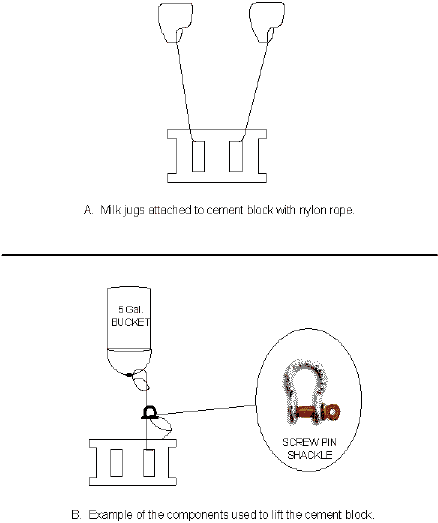
Diagram 1. Block assemblies
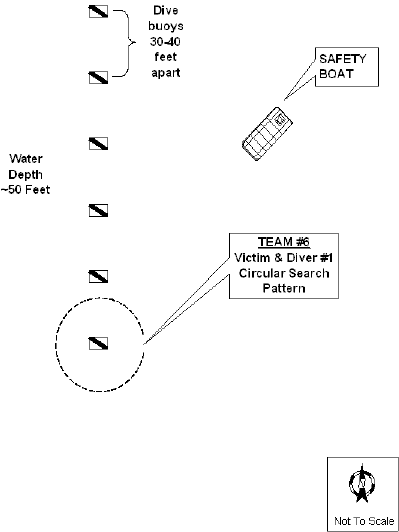
Diagram 2. Aerial view, dive team setup
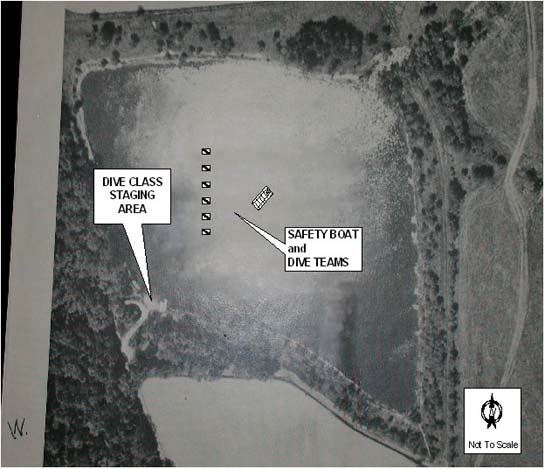
Photo 1. Aerial photo; Dive site
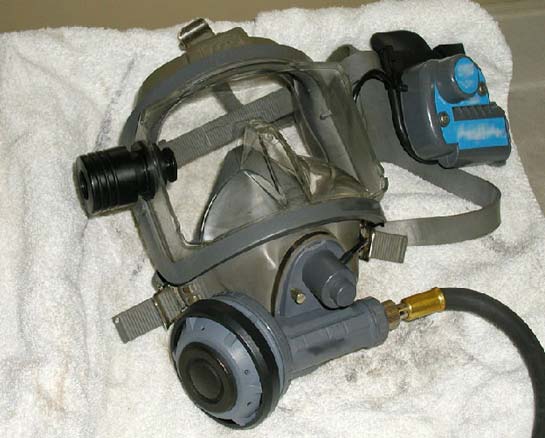
Photo 2. Example of dive mask used by the victim
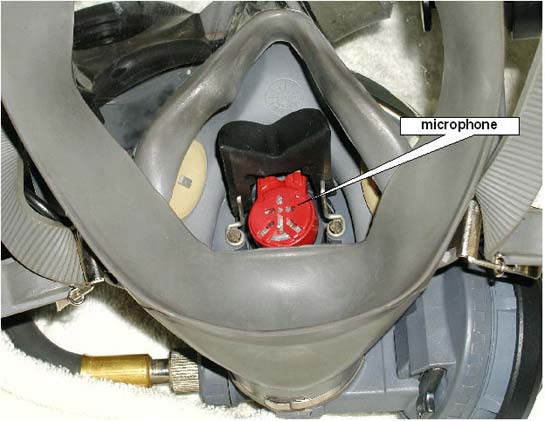
Photo 3. Example of microphone that was not working
This page was last updated on 07/21/03
